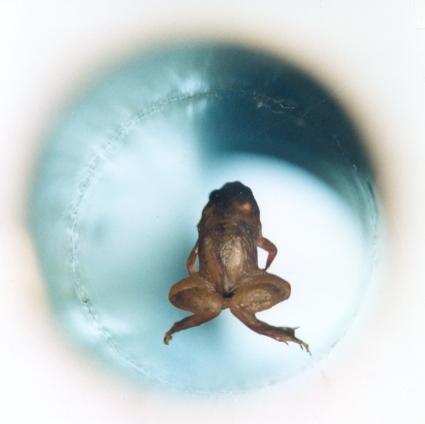DIAMAGNETIC LEVITATION
“…The ship rolled out of the hangar like an air-borne whale, moving slowly, its diamagnetized hull clearing the smooth-packed clay of the field by three inches. The ship came to a halt, pinpointed at the lip of a take-off pit. The diamagnetic field strengthened progressively towards the ship's prow and it began tipping upward. Terens was mercifully unaware of this as the pilot room turned on its universal gimbals to meet the shifting gravity. Majestically, the ship's rear flanges fitted into the appropriate grooves of the pit. It stood upright, pointing to the sky…” From The Currents of Space, by Isaac Asimov. Published by Doubleday in 1962

Diamagnetic levitation differs from any other known way of levitating or floating things. The gravitational force is compensated on the level of individual atoms and molecules, which is as close as we can get to the science fiction dream of an anti-gravity machine. This means it’s not necessary to organize a space mission to study the effects of microgravity; experiments can be performed inside a magnet instead….like growing crystals or body tissue without a scaffold.
Diamagnetic levitation enables objects to levitate at room temperature on earth without using power. Originally invented in 1939, this little-known technology was used primarily in scientific novelties. However, diamagnetic levitation has a much broader scope, including micro factory systems, levitated sensors of exquisite precision, and lossless bearings with unlimited lifetimes. Diamagnetic levitation is often used with electro-magnetic drive forces to enable high speed and precise motion.
While at SRI, Ron invented the first self-levitated magnetic structure using diamagnetism, which enables micro factory and long motion transport. Diamagnetic levitation is primarily a small to medium scale phenomenon on earth. In space however, this technology is no longer limited to small objects, potentially enabling the levitation of much larger objects and structures.
Ron is the principal inventor on numerous patents in this field, including a license for levitated toys and novelties, and a license for micro robotic patents, for use in the levitated micro factory system.

Radbaud University’s picture of levitated alive frog suspended in a water ball levitated inside a Ø32mm vertical bore of a Bitter solenoid in a magnetic field of about 16 Tesla.
“…The ship rolled out of the hangar like an air-borne whale, moving slowly, its diamagnetized hull clearing the smooth-packed clay of the field by three inches. The ship came to a halt, pinpointed at the lip of a take-off pit. The diamagnetic field strengthened progressively towards the ship's prow and it began tipping upward. Terens was mercifully unaware of this as the pilot room turned on its universal gimbals to meet the shifting gravity. Majestically, the ship's rear flanges fitted into the appropriate grooves of the pit. It stood upright, pointing to the sky…” From The Currents of Space, by Isaac Asimov. Published by Doubleday in 1962

Diamagnetic levitation differs from any other known way of levitating or floating things. The gravitational force is compensated on the level of individual atoms and molecules, which is as close as we can get to the science fiction dream of an anti-gravity machine. This means it’s not necessary to organize a space mission to study the effects of microgravity; experiments can be performed inside a magnet instead….like growing crystals or body tissue without a scaffold.

Radbaud University’s picture of levitated alive frog suspended in a water ball levitated inside a Ø32mm vertical bore of a Bitter solenoid in a magnetic field of about 16 Tesla.
Diamagnetic levitation enables objects to levitate at room temperature on earth without using power. Originally invented in 1939, this little-known technology was used primarily in scientific novelties. However, diamagnetic levitation has a much broader scope, including micro factory systems, levitated sensors of exquisite precision, and lossless bearings with unlimited lifetimes. Diamagnetic levitation is often used with electro-magnetic drive forces to enable high speed and precise motion.
While at SRI, Ron invented the first self-levitated magnetic structure using diamagnetism, which enables micro factory and long motion transport. Diamagnetic levitation is primarily a small to medium scale phenomenon on earth. In space however, this technology is no longer limited to small objects, potentially enabling the levitation of much larger objects and structures.
Ron is the principal inventor on numerous patents in this field, including a license for levitated toys and novelties, and a license for micro robotic patents, for use in the levitated micro factory system.
